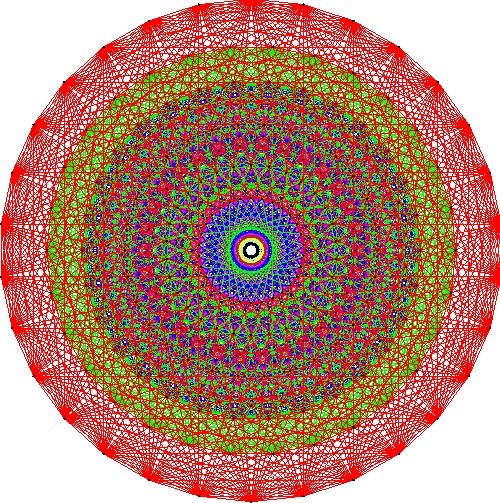What is a group?
Mathematicians invented the concept of a group
to capture the essence of symmetry. The collection of symmetries
of any object is a group, and every group is the symmetries of
some object. E8 is a rather complicated group: it is the symmetries
of a particular 57 dimensional object, and E8 itself is
248 dimensional! E8 is even more special: it is a Lie
group, which means that it also has a nice geometric structure.
The theory of groups has found widespread application.
It was used to determine the possible structure of crystals,
and it has deep implications for the theory of molecular vibration.
The conservation laws of physics, such as conservation of energy
and conservation of electric charge, all arise from the symmetries
in the equations of physics. And one of the simplest groups,
known as "the multiplicative group modulo N" is used
every time you send secure information over the Internet.
For an introduction to groups requiring little
mathematics background, see Groups and Symmetry by David Farmer.
What is a Lie group?
Lie groups lie at the intersection of two fundamental fields
of mathematics: algebra and geometry. A Lie group is first of
all a group. Secondly it is a smooth manifold which is a specific
kind of geometric object. The circle and the sphere are examples
of smooth manifolds. Finally the algebraic structure and the
geometric structure must be compatible in a precise way.
Informally, a Lie group is a group of symmetries
where the symmetries are continuous. A circle has a continuous
group of symmetries: you can rotate the circle an arbitrarily
small amount and it looks the same. This is in contrast to the
hexagon, for example. If you rotate the hexagon by a small amount
then it will look different. Only rotations that are multiples
of one-sixth of a full turn are symmetries of a hexagon.
Lie groups were studied by the Norwegian mathematician
Sophus Lie at the end of the 19th century. Lie was interested
in solving equations. At that time techniques for solving equations
were basically a bag of tricks. A typical tool was to make a
clever change of variables which would make one of the variable
drop out of the equations. Lie's basic insight was that when
this happened it was due to an underlying symmetric of the equations,
and that underlying this symmetry was what is now called a Lie
group.
Lie groups are ubiquitous in mathematics and
all areas of science. Associated to any system which has a continuous
group of symmetries is a Lie group.
The basic building blocks of Lie groups are
simple Lie groups. The classification of these groups starts
with the classification of the complex, simple Lie algebras.
These were classified by Wilhelm Killing and Elie Cartan in
the 1890s.
Cartan constructed all the simple Lie algebras,
which correspond to the simple root systems: An, Bn, Cn, and
Dn (n=1,2,3....) and the exceptional ones: G2, F4, E6, E7, and
E8. The exceptional ones have dimensions 14, 52, 78, 133 and
248, respectively.
For a Lie group, the subscript n is called the
rank of the group, which is a measure of how large the group
is. In a sense E8 is the most complicated Lie group. Although
A1000, for example, is certainly larger than E8, mathematicians
know how to describe the representations of An for every n,
so there is nothing special about A1000. All of An, Bn, Cn,
and Dn are well-understood, so the remaining challenge is to
tackle the exceptional groups. All 5 of the exceptional groups
need to be treated separately, and E8 is the most complicated
of these.
(Fonte)

|